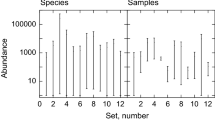Abstract
Variance deficit in the number of species per sampling unit, as compared to a null model with species occurring independently of each other has been considered by various authors to be evidence for niche limitation. I show that simpler mechanisms could explain this phenomenon. Of those, the competition of individuals for space limits the number of individuals per sampling unit, resulting in decrease of variance in species richness. Testing the proportions of species belonging to various guilds seems to be more ecologically interesting, although here also the variance deficit can hardly be taken as reliable evidence for niche limitation.
Similar content being viewed by others
References
Barton D.E. &David F.N. (1959): The dispersion of a number of species.—J. Roy. Statist. Soc. Ser. B 21: 190–194.
Bycroft C.M., Nicolaou N., Smith B. &Wilson J.B. (1993): Community structure (niche limitation and guild proportionality) in relation to the effect of spatial scale, in aNothofagus forest sampled with a circular transect.—New Zealand J. Ecol. 17: 95–101.
Kershaw K.A. (1974): Quantitative and dynamic plant ecology.—Edward Arnolds, London.
Klimeš L., Jongepier J.W. &Jongepierová I. (1995): Niche limitation, guild structure and small-scale dynamics in species-rich grassland.—Folia Geobot. Phytotax. 30: 243–253.
Lepš J. (1990): Can underlying mechanisms be deduced from observed patterns?.—In:Krahulec F., Agnew A.D.Q., Agnew S. &Willems J.H. [eds.]: Spatial processes in plant communities, SPB, The Hague, pp. 1–11.
Lepš J. &Buriánek V. (1990): Pattern of interspecific associations in old field succession.—In:Krahulec F., Agnew A.D.Q., Agnew S. &Willems J.H. [eds.]: Spatial processes in plant communities, SPB Publ., The Hague, pp. 13–22.
Lepš J. &Hadincová V. (1992): How reliable are our vegetation analyses?.—J. Veg. Sci. 3: 119–124.
Lepš J. & Rejmánek M. (in press): Interspecific association can reveal competition:Cirsium vulgare andArctostaphylos patula in a clearcut succession.—Oikos.
Palmer M.W. &van der Maarel E. (1995): Variance in species richness, species association, and niche limitation.—Oikos 73: 203–213.
Pielou E.C. (1972): 2k contingency tables in ecology.—J. Theor. Biol. 34: 337–352.
Pielou E.C. (1975): Ecological diversity.—John Wiley, New York.
van der Maarel E., Noest V. & Palmer M.W. (in press): Variation in species richness on small grassland quadrats: niche structure or small-scale plant mobility?—J. Veg. Sci.
Wilson J.B. (1989): A null model of guild proportionality, applied to stratification of a New Zealand temperate rain forest.—Oecologia 80: 263–267.
Wilson J.B., Gitay H. &Agnew A.D.Q. (1987): Does niche limitation exist?—Funct. Ecol. 1: 391–397.
Wilson J.B. &Roxburg S.H. (1994): A demonstration of guild-based assembly rules for a plant community, and determination of intrinsic guilds.—Oikos 69: 267–276.
Wilson J.B., Roxburgh S.H. &Watkins A.J. (1992): Limitation to plant species coexistence at a point: a study in a New Zealand lawn.—J. Veg. Sci. 3: 711–714.
Zobel K., Zobel M. &Peet R.K. (1993): Change in pattern diversity during secondary succession in Estonian forests.—J. Veg. Sci. 4: 489–498.
Author information
Authors and Affiliations
Rights and permissions
About this article
Cite this article
Lepš, J. Variance deficit is not reliable evidence for niche limitation. Folia Geobot 30, 455–459 (1995). https://doi.org/10.1007/BF02803975
Issue Date:
DOI: https://doi.org/10.1007/BF02803975




